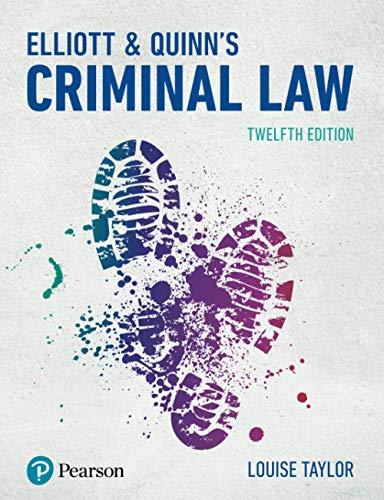Question
PART I. MULTIPLE CHOICE: ______ 1. Jury instructions are issued by (a) the jury Foreman (b) the Bailiff or Marshall (c) the Judge (d) the
PART I. MULTIPLE CHOICE:
______ 1. Jury instructions are issued by (a) the jury Foreman (b) the Bailiff or Marshall (c) the Judge (d) the attorneys. ______ 2. False imprisonment (a) is the same as Kidnapping (b) requires that there be no reasonable means of escape (c) is always considered a crime (d) never applied to someone being detained for alleged shoplifting. ______ 3. The use of explosives or crop dusting are considered (a) negligence torts (b) business torts (c) intentional torts (d) abnormally dangerous activities. ______ 4. An example of Alternative Dispute Resolution is (a) Arbitration (b) plea-bargaining (c) a bench trial (d) depositions. ______ 5. The hardest element to prove in any crime is (a) proximate cause (b) damages (c) intent (d) minimum contacts. ______ 6. The Constitutional protection against being tried more than once for the same crime is called (a) double jeopardy (b) the Takings Clause of the Constitution (c) the Supremacy Clause of the Constitution (d) the Necessary and Proper Clause of the Constitution. ______ 7. If there is "no defense" to a particular tort, it is considered (a) strict liability (b) negligence (c) an intentional tort (d) a default judgment. ______ 8. The Amendments that create the basis of Criminal Procedure rights and protections are: (a) the 1st, 2nd, 4th and 5th Amendments (b) the 4th, 5th, 6th, and 8th Amendments (c) the 1st, 4th, 5th, and 6th Amendments (d) the 2nd, 4th, 5th, and 8th Amendments. ______ 9. Which of the following is NOT part of a case that is being heard on appeal: (a) juries (b) witness testimony (c) a review of the evidence in the trial (d) only "a" and "b" (e) all of the above. ______ 10. The belief that a crime has been committed and that there is reasonable likelihood that a particular person is connected to that crime which is the basis of obtaining a warrant is called: (a) reasonable doubt (b) proximate cause (c) probable cause (d) minimum contacts. ______ 11. The process of jury selection is called (a) voir dire (b) alternative dispute resolution (c) jury instructions (d) personal service of process. ______ 12. If you are a celebrity or famous person and you are suing someone for Defamation, what additional element must you show? (a) that your reputation was harmed (b) actual malice (c) that the statement is untrue (d) that someone invaded your privacy. ______ 13. Burden of proof is (a) how you measure how much damages should be paid to a Plaintiff (b) the amount of evidence that must be assembled (c) the level of certainty that a jury must have that someone is responsible or liable (d) what the Appellate Court decides. ______ 14. Intellectual Property is governed by the U.S. Constitution. (T/F) ______ 15. The authority of a court to hear a case and render an enforceable decision is (a) venue (b) jurisdiction (c) voir dire (d) probable cause. ______ 16. A television station is an example of (a) an element of commerce (b) a stream of commerce (c) a channel of commerce (d) an instrumentality of commerce.
Step by Step Solution
There are 3 Steps involved in it
Step: 1

Get Instant Access to Expert-Tailored Solutions
See step-by-step solutions with expert insights and AI powered tools for academic success
Step: 2

Step: 3

Ace Your Homework with AI
Get the answers you need in no time with our AI-driven, step-by-step assistance
Get Started


